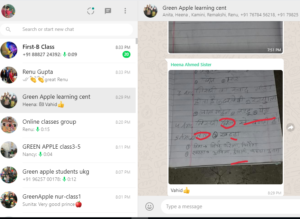In March 2020, at the Green Apple learning Centre, we excitedly went about preparations for new Academic Year. Located in the Shakurpur slum in Northwest Delhi, the learning center catered to 250 primary school kids of largely casual labour and migrant families. Covid-19 was spreading rapidly and caught us all unprepared for what was to follow.

With nationwide lockdown announced on March 25, all our plans for the learning center went astray. Overnight the center was closed. Some of the kids left for their hometowns in Bihar and UP. We had no backup plans for continuing teaching during the lockdown.
My nine-year-old niece who attended a private school switched to on-line classes in the first week of April through Zoom. My niece had access to a laptop, a tablet and her mothers’ phone. Her educated mother understood the instructions issued by the school to navigate the Zoom classes and assisted my niece to complete the course work.
We were determined to find a solution for Green Apple learning center kids. Unfortunately, none of them had had a laptop or a tablet. Their parents had only one phone. Only half of the parents had a basic smartphone. None of them had wifi. Cellular data was the only source to access the internet–largely due to the cheapest cellular data plans in the world at less than USD 3 per month. With three to four children in the family competing for the same phone in congested one-room tenements, holding interactive scheduled video classes was not an option.
On April 7, we met over Zoom to find ways to teach our kids. Teachers were quick to navigate Zoom. We had phone numbers of children’s parents. We decided to adopt Whatsapp. Each of the teachers made a Whatsapp class group. Kids with parents with smartphones joined the Whatsapp. An online repository of teaching material was developed using Google drive. This also included a playlist of suitable videos linked to Youtube. Training sessions introduced teachers to Google drive and Youtube playlists, and how to access the central repository on Google drive. The first Whatsapp class began on April 11—with half of the children joining. It was heartening to see some of the children joining from their native places in Bihar.
Teachers are improvising every day—live audio feedback to online checking out of worksheets, to personal calls, to the oral poem and story recitation. The response rate is gradually improving.
We have unresolved challenges. We have no solution for children who had no access to a smartphone, apart from direct phone calls. With recent partial lifting up of lockdown, we are losing some kids as the parents start going out for work with their phones.
This crisis gave us the opportunity to figure out the solution to our major problem—on how to maintain continuity of learning during the normal academic sessions when parents shuttle back and forth between their village and Delhi. We still need to figure out how to increase access to a smartphone or a tablet to families not have them now. We may explore the idea of creating some community-based phone or tablet banks. We may get some great ideas and suggestions from the readers of this paper, who knows!.
